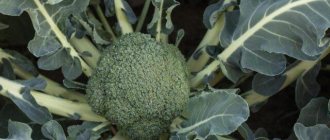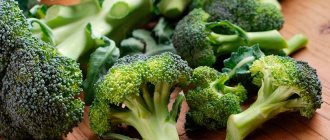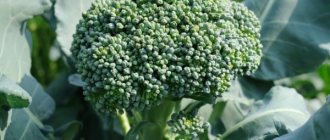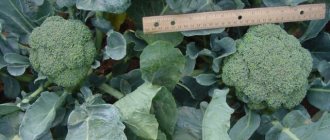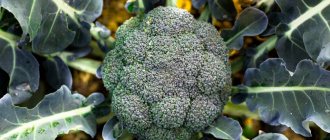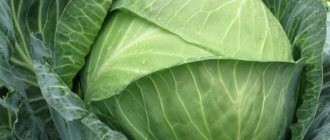Broccoli in Russia is still much inferior in popularity to white cabbage and cauliflower, which have long been familiar to gardeners. But the situation is gradually changing, and this is facilitated by the regular appearance on the market of varieties and hybrids that combine high productivity, rich chemical composition and good taste with “marketability”, keeping quality and ease of cultivation. The Monaco F1 broccoli hybrid meets all these criteria. It was created in the Netherlands, but quickly and successfully took root in Russian regions with very different climates.
Description and characteristics of broccoli Monaco F1
Monaco F1 is a first generation broccoli hybrid, created by one of the world famous Dutch agribusinesses. It went on sale in its homeland in 2008, at which time an application for official registration in the Russian Federation was submitted. All necessary variety tests were completed in 2012, and from that moment on, hybrid broccoli was listed in the Russian Register of Breeding Achievements.
Now you can purchase domestic seeds produced under an agricultural license
It is officially recommended for cultivation by amateur gardeners. The most preferred regions for its cultivation are not indicated: Broccoli Monaco F1 has adapted well both in the south and in areas with a much more severe climate (Urals, Siberia, Far East, North-West).
Monaco F1 is a late-ripening hybrid. It takes 115-125 days for the heads to mature. This is due to the feature that distinguishes it from most other varieties of broccoli. When the head is cut off, “additional” smaller ones on the side branches of the stem are not laid, which is logical: they probably will not have time to ripen before frost.
The rosette of leaves of the Monaco F1 broccoli is powerful, but relatively compact, semi-raised. The leaves are medium-sized and have a typical cabbage color. There is also a characteristic “waxy” coating, a slight “bubbling” of the surface and “wavy” edges.
The plant reaches a height of about 50 cm, forms a single stem
The average weight of Monaco F1 broccoli heads is 0.6 kg. They are round in shape (less often dome-shaped), very dense, but at the same time juicy grayish-green in color. The “lumpy” surface is not very pronounced. Cover leaves are absent.
In very favorable conditions and with quality care, the heads can gain weight up to 1.5-2 kg
Important! The delicate sweetish taste of Monaco F1 broccoli is described in the State Register as “excellent.” Based on its culinary purpose, this is a universal hybrid, suitable for any dishes and home canning, as well as for freezing.
Productivity
According to the Russian State Register, the yield of Monaco F1 broccoli is 4.2 kg/m². The originator indicates different data in the varietal characteristics - 7-8 kg/m². Such a significant “scatter” can easily be explained by differences in climatic conditions.
"Partenon F1"
A high-yielding mid-season variety, the ripening time of which occurs 85 days after germination. It grows in one head, suitable for planting in the garden and greenhouse. Variety characteristics:
- vegetable weight - from 0.6 kg to 1 kg;
- the inflorescences are densely located to each other, they are dark green in color with a grayish tint;
- rarely exposed to diseases of the cruciferous family;
- universal use - fresh, frozen, canned;
- high commercial qualities;
- long shelf life.
6 varieties of pepper tomatoes that will delight you with an abundance of harvest
Seedlings quickly adapt after planting and do not require special conditions during planting and growth, and safely tolerate temporary unfavorable weather “whims” - drought, small floods.
Advantages and disadvantages
Broccoli Monaco F1 in Russia is not officially recognized as suitable for cultivation on an industrial scale and private farms, although it has good keeping quality and transportability. An obstacle is the real risk of crop loss when grown in open ground due to early first frosts, when the temperature drops sharply below -7 ºС.
Broccoli Monaco F1 is easily “disassembled” into individual inflorescences, which is very convenient both for preparing any dishes and for freezing
Pros:
- the ability to adapt to different and not always favorable climatic nuances;
- endurance and “stress resistance”, good resistance to negative external influences;
- stable yield, little dependent on weather during the season;
- undemanding in terms of care;
- high resistance to fungal and other diseases typical of the culture;
- keeping quality and transportability of heads;
- external presentability of broccoli;
- versatility of purpose, suitability for any “culinary” purposes.
Minuses:
- long growing season;
- frequent cases of “attack” by pests typical for the crop, the need to apply appropriate preventive measures.
Diseases and pests
Manoko is immune to Fusarium wilt.
Some of the most dangerous insects for Chinese cabbage are:
- cruciferous flea beetle, black, wavy;
- cabbage moth, fly, bug;
- winter cutworm, garden;
- whitefish;
- centipede;
- wireworm;
- mole cricket;
- aphid.
In pest control, insecticides for arachnid insects - insectoacaricides - are used. The treatment is carried out several times.
Diseases affecting cruciferous plants: vascular bacteriosis, tracheomycosis, mosaic, phomosis (dry rot), white rot, downy mildew. For fungal diseases, the following solutions are used: “Topaz”, “Quadrisom”, “Skorum”, etc. Vegetable crops with viral diseases cannot be treated - they are removed (burned).
Landing Features
Due to the long growing season, Monaco F1 broccoli is grown mainly in seedlings. The procedure follows a standard algorithm, including pre-planting preparation of seeds in the form of soaking in a biostimulant solution. To avoid the picking stage, it is better to immediately plant them in small peat pots or plastic cups.
Important! The root system of Monaco F1 broccoli is powerful and well developed, so a maximum of 4-5 rosettes are placed per 1 m². The minimum interval between neighboring plants is 40 cm, row spacing is 60 cm.
When to plant seedlings
Seedlings begin to be grown from the second half of March to mid-April. The specific period depends on the local climate. From the moment the seedlings emerge until the seedlings are transplanted into the ground, 40-45 days should pass. During this time, they develop 5-6 true leaves.
Before planting in the ground, it is advisable to harden the seedlings
Sowing in open ground
Growing Monaco F1 broccoli by sowing seeds directly into a garden bed in Russia can only be practiced in southern regions with a subtropical climate. They are planted in mid-April, following the recommended planting pattern.
Several seeds are sown in the “holes”. When a pair of true leaves is formed on the seedlings, “culling” is carried out, leaving one copy at a time. High-quality seedlings are used to fill the resulting “gaps”.
When planting seeds directly into the garden bed, the harvest will have to wait at least 15-20 days longer.
Important! If the climate in the region allows, Monaco F1 broccoli can be sown in several “waves” between mid-April and the end of May at intervals of 12-15 days.
Care
When growing the Manoko F1 variety, seedling and non-seedling sowing methods are used. The hybrid is resistant to cold, the seeds are able to germinate at low temperatures (4°C), but for good and rapid development, the optimal temperature should be 15-20°C, therefore, for the first spring cultivation, seeds are sown for seedlings.
Sowing and seed treatment
Sowing work is carried out 2 times per season: in spring and summer. First sowing - April 1-10; transplanting seedlings into the ground - the first ten days of May. The second - from June 20 to July 1; landing - from mid-July.
Before sowing, the seeds are treated: dipped in hot water (50°C) for 20 minutes, you can use a thermos, and then transferred to cold water for 5 minutes.
The soil for seedlings is loose, using peat, turf soil and humus. The hybrid does not recover well after picking, so the seeds are planted in a separate container. Peat tablets, pots and cassettes work great.
Lighting
Seedlings need good lighting
Containers with seeds should be stored in a dark, warm place until germination. After the first shoots appear, the seedlings are provided with regular lighting for 10-14 hours. For this purpose, phytolamps are used.
Temperature and watering
For the first 2 weeks after germination, the air temperature should not exceed 7-8°C. After this period, the temperature is increased to 15-18°C. Water for irrigation is used at room temperature. Water as needed, do not allow the soil to dry out or become waterlogged. In the spring, a week before planting, the seedlings are hardened: they are taken out into the fresh air, increasing the time spent outside every day.
Transfer
The soil for seedlings should be fertile, moderately moist (ideal moisture content is 70%). Good predecessors are pumpkin, legumes and grains, onions, garlic, green manure. Growing after beets, tomatoes and all cruciferous and cabbage relatives is not recommended, as they have common diseases. The transplant takes place according to the 60 x 40 cm pattern.
Watering after planting
Manoko cabbage requires regular, abundant watering every 5 days, early in the morning or in the evening, after sunset. The water should be settled and warm. When watering, it is undesirable to allow water to get on the leaves; pour only under the roots. To retain moisture for a longer time, the bed is mulched. In this case, you will not have to loosen the soil and remove weeds so often.
Fertilizer
Cabbage planted in the spring is fertilized 3 times during the entire growing season. For the second landing in the summer, 2 times are enough. For root feeding, solutions of mullein, chicken manure or fertilizer based on N, P, K (nitrogen, phosphorus, potassium) are used. During the ripening of the heads of cabbage, the plants are sprayed with a solution of water (10 l) and boric acid (2 g). All feeding is carried out in the evening.
Features of care
To get a good harvest of Monaco F1 broccoli, it is enough to provide it with:
- Watering. Usually once a week is enough (2-3 liters per plant). If there is no rain and the temperature rises above 25 ºС, the substrate is moistened twice as often.
- Feeding. The first (nitrogen) is carried out 12-15 days after transplanting seedlings into the garden bed or 25-30 days after germination of seeds sown immediately in open ground. After waiting 15-20 days, then complex fertilizers containing potassium and phosphorus are applied at monthly intervals.
- Loosening and hilling. The soil in the bed with Monaco F1 broccoli is loosened to a depth of about 8 cm 2-3 times a month (ideally, after each watering). The rosettes are earthed up three weeks after transplanting to the garden bed and again after 1.5 weeks.
In addition to watering, Monaco F1 broccoli responds very positively to foliar spraying
Important! To prevent pest attacks, it is quite possible to use folk remedies. And in the event of a “massive” insect attack on the garden, it is better to pre-treat the Monaco F1 broccoli with suitable insecticides.
"Ironman F1"
One of the most popular and sought after varieties for growing in cold regions with unstable weather conditions and short summers. Variety characteristics:
- undemanding in care when growing;
- The yield is high - up to 3 kg per square meter. m;
- balanced taste, juicy inflorescences, without bitterness;
- heads weighing up to 0.6 kg;
- ripening time - 85-100 days;
- color - dark green with blue;
- after cutting the main head, secondary ones grow, weighing up to 250 g.
Ironman is used for preparing fresh salads, canning, and making purees. The heads tolerate transportation well, do not rot, do not crack, and retain their useful properties and appearance for a long time.
Cold weather conditions and a short summer are not a reason to give up growing broccoli. It’s better to choose special varieties that are adapted to such conditions.
Harvest and storage
Since Monaco F1 broccoli does not tend to bush, the entire crop can be harvested at one time. From the moment of transplantation into open ground, approximately 70-75 days pass.
You can’t delay harvesting too much; “overripe” yellowing cabbage is no longer suitable for food.
It is best to cut the heads of Monaco F1 broccoli in the morning or late at night - at this time they gain maximum juiciness. You need to choose a moment when the weather is dry for at least several days in a row so that the cabbage does not become “saturated” with moisture: this shortens its shelf life and makes the taste less rich.
Important! Monaco F1 broccoli heads are cut off along with a part of the stem 8-10 cm long.
At room temperature, Monaco F1 broccoli will last for about two weeks. In a cellar, basement, or other place with an air temperature of 2-4 ºС, humidity 85-90% and good ventilation - up to three months. The heads are laid out in separate plastic bags, after making several holes in them and wrapping part of the stem with a damp cloth. Frozen Monaco F1 broccoli has the longest shelf life (about six months).
In bags and containers, broccoli is “packed” in small portions - defrosting and re-freezing are contraindicated for it
Features of cultivation
Early Chinese cabbage requires a lot of nutrition and fertile soil. Its agricultural technology is not too different from other varieties. The main thing is special attention to the timing of planting in order to prevent the Manoko seedlings from freezing and have time to grow 2 or even 3 crops per season.
Preparing seedlings
In the case of Manoko, this type of planting is preferred. Planting of seed material begins in early April. Seeds for seedlings are placed in separate pots, 3-4 seeds each. Containers with Chinese cabbage are placed in a cool place with a temperature no higher than 18°. Water as the soil dries. Bright light should fall on them no less than 10 and no more than 14 hours a day.
Site preparation
Manoko ripens best in humus-rich, well-moistened soils with a neutral acidity level. Since the fall, according to the description, the area has been cleaned, disinfected and manured.
Before planting, the soil for Chinese cabbage is once again fertilized with chicken droppings and ash and treated to remove weeds. If necessary, treat against insects.
Transplanting
Manoko seedlings are planted in the ground or greenhouse in early May. By this time, the sprouts should have 8 leaves so that the plant is strong and does not bolt. To prevent Chinese cabbage from freezing, the optimal soil temperature should reach 20°-21°. The distance between the sprouts is 40 cm, and the space between adjacent rows is 60 cm.
